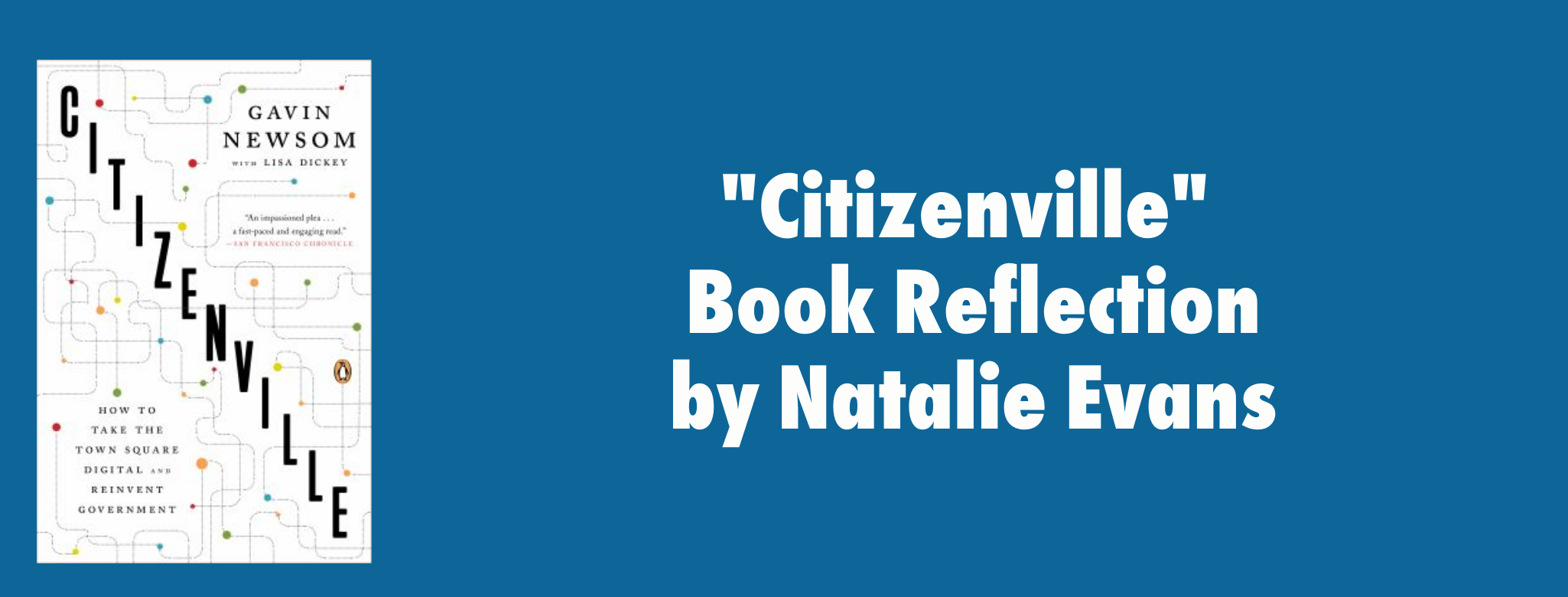
On February 18, 2021, ELGL members discussed “Citizenville” by California Governor Gavin Newsom for the ELGL Book Club. We gave away six signed copies of the book to our members and asked them to write reflections on the book. Here’s the reflection post by Natalie Evans.
The world of technology and digital platforms is ever-changing. Over 592 million daily app downloads occurred per day in 2020. Over 2.8 billion active users are on Facebook. 13,400 tech startups launched in 2019. Our residents are plugged into this digital world. But, in a world of constant change, where does government fit in, and are we changing fast enough to keep up?
Gavin Newsom’s Citizenville argues that government is behind in the world of technological advancements. But, there is hope. Citing positive examples of communities across the world, Newsom argues that we can become a part of and empower the digital revolution.
“How to take town square digital and reinvent government.” This is an auspicious subtitle to Gavin Newsom’s Citizenville, but a statement that became highly relatable in 2020, the year of adaptations because of COVID-19. Gone were the days of in-person town halls and face-to-face engagement. Local governments had to find ways to pivot and do nearly everything online, while remaining compliant with state and federal regulations.
But, in the midst of chaos, uncertainty, and fear, something happened. “We’ve always done it this way” became a statement totally invalidated by circumstances. Not only would the way we’d always done it not function as well, it simply was not an option anymore. To cite a few examples in our community… We began having City Council and board and commission meetings virtually. We began accepting applications and documents online, when they had only been accepted in-person prior. Employees began to work from home. Our IT Department (total rock stars) took action immediately and adapted many processes to work online, away from the offices.
Our mini tech revolution was spurred on because of an emergency. This happened seven years after the publication of Citizenville, and in reading this book, I found we had just begun to adopt some of the concepts Newsom had been advocating for nearly a decade ago.
Citizenville is an idealistic picture of how government can better use technology as a way of providing services, making effective changes, and connecting with our residents. His book is a rallying cry for us to reinvent the way we exist and challenge our current practices, becoming more efficient and transparent in our use of technology.
Discussing everything from open data platforms to social media to data programming, Newsom explores the ways that governments can adapt to become a better participant in and advocate for the digital world. He argues that in many ways, government of today is stuck in the past, restricted by practices that are done the way they have always been done.
The examples provided and topics discussed are wide-ranging, but I wanted to highlight a few key topics where I gained insights.
Be Proactive About Transparency
Government is open to the public. We have to be. Often, however, this openness is reactive. It is through an open records request or through a subpoena. Open data platforms and transparency initiatives have shifted open government to becoming more proactive than reactive.
I am a big fan of open data platforms. Not only are they an excellent tool for transparency, they are also a great way of educating the public and providing businesses and individuals the information they need. It is a proactive, not reactive approach. We don’t just need to be transparent. We need to be proactive about transparency. What data points do we get frequent records requests about? How can we take that data, make it accessible, and automate its reporting? Newsom not only advocates for open data sharing, but also getting our residents to use that data to innovate and tell us where to improve.
Government as a Platform
This was a concept discussed in the Master of Public Administration program I went through. The tangible examples presented in Newsom’s book, however, made this concept stick. By making our data available, encouraging its use, and promoting those who do so, we can pave the way for innovations in government.
Of course, we aren’t all as lucky as Newsom was to work for a municipality bordering Silicon Valley. There, the opportunities for partnerships with the technology sector are abounding. However, all of us, no matter what municipality we are in, have talented, intelligent, skilled residents who, when given the change, may want the opportunity to take a more active role with our processes. We should empower them to do so.
By the People, For the People
We need to engage our people. This isn’t a unique concept for anyone in local government, but we should always be revaluating our approach to community engagement and participation of the people. “Technology puts power in the hands of the people – if only we let it.”
Keep It Simple, Stupid
The discussion of technology in government can get complex. Fast. When it comes to public participation in government, Newsom argues a different approach. “We’ve got to simplify, pull back all these layers of supposed complexity, and get down to the essentials… I truly believe that it’s not the problems we face that are complex – it’s the system we’ve designed to solve them that’s complex. Yet we hold onto that system because it’s the way we’ve always done things.”
The era of “that’s the way we’ve always done it” is gone. Here is the opportunity for us to find a better way.
